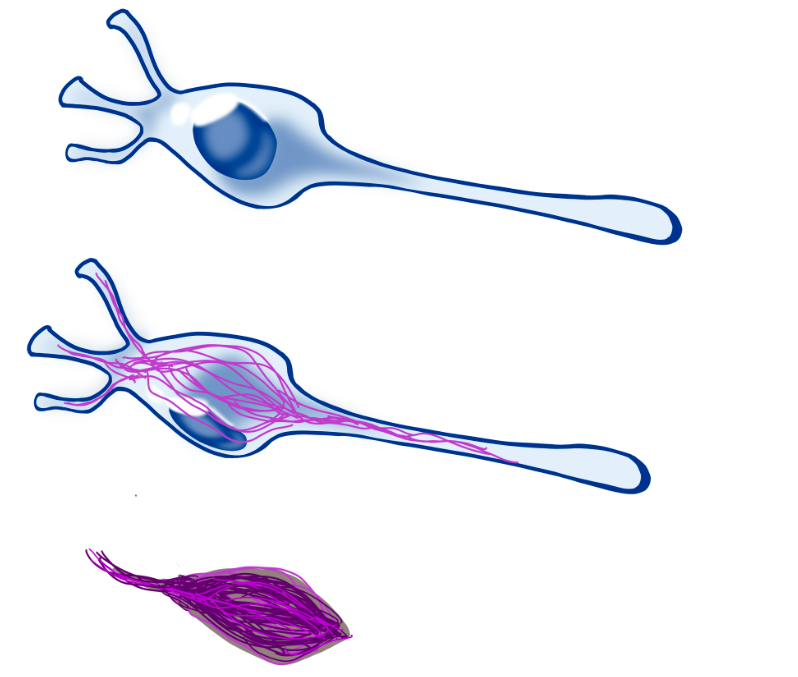Dr Miguel Ramirez Moreno studies tau through his work as a postdoctoral researcher with Professor Amrit Mudher, through her AS funded project grant. Miguel has put together this helpful explainer on tau's function in dementia.
What is tau?
Tau is a protein naturally produced by our cells, helping them function properly. Its roles include supporting the internal structure of cells - by acting as a kind of strengthening scaffolding - to make them stronger.
This is especially important for our neuron cells, as they need to be made up of strong and resilient parts, to communicate with each other, transporting everything from electric signals to vital nutrients
Good maintenance by proteins like tau keeps our bodies working efficiently. However, tau has gained a negative reputation because it is involved in several diseases that lead to dementia, including the most common one, Alzheimer’s disease.
In the image above, we see a healthy neuron (top). tau acts normally across the structure of a neuron, but abnormal tau starts forming fibrous tangles (centre), that eventually are all what remains of the neuron (bottom).
Did you know... We all have tau inside our brains – inside every one of our cells. And normally that is fine. The problem is not the protein itself, but its behaviour.
Untangling findings on tau and Alzheimer’s disease
Dementia is not a single disease, but a syndrome caused by many different conditions affecting the brain. Alzheimer’s disease is responsible for more than half of all the diagnosed cases of dementia.
The disease was first spotted over a century ago, by Alois Alzheimer. He described the strange clumps he’d seen inside of the brains of people affected - fibre-like structures, or “tangles”.
As is often the case with major scientific breakthroughs, it took a collaborative effort to understand what these fibres actually were.
In 1975, a group at Princeton University (USA) discovered tau as a protein involved in protecting the internal structure of the cells. But it was not until 1988 that several scientists at Cambridge University (UK) found out that tau was making the tangles that Alzheimer described decades earlier.
The mystery of the tangles Alois Alzheimer had seen was solved: Finding tau was present in a form it should not be in Alzheimer’s disease. But this opened up more questions for researchers of Alzheimer’s disease. what Was this just an unusual presentation or something more? Could tau be responsible of for damaging our neurons getting hurt?
How relevant is tau for dementia?
Alzheimer’s disease is marked by the presence of abnormal tau tangles, alongside excessive depositions of amyloid beta – commonly known as senile plaques.
Scientists have discovered many ways in which these two proteins interact in the disease process. According to the amyloid cascade hypothesis, amyloid beta is disrupted first, which subsequently leads to changes in tau and other proteins. Abnormal tau is also linked to many other forms of dementia, either on its own or in combination with other proteins. This is why these conditions are collectively referred to as ‘tauopathies’. In each of these diseases, tau may be more or less important, but it is always involved.
What do and don’t we know about tau?
When tau protein becomes abnormal, it stops doing its usual job of keeping brain cells healthy. This leaves the cells more vulnerable to damage. But it doesn’t just stop helping, it can start harming the brain.
Scientists have found that abnormal tau can move from one neuron to another, which helps explain how the damage spreads across the brain in diseases like Alzheimer’s.
What research are Alzheimer's Society supporting into tau?
Research will beat dementia and will lead to improved diagnosis, effective treatments and the high-quality care that everyone living with dementia deserves. Learn more about some of the research we are funding to answer the outstanding questions about the tau protein, and how it could be targeted by future treatments.



Patricia Humphrey
saysSusanne Coysh
says
Alzheimer's Society
saysHi Susanne,
Thanks for your questions.
Researchers are investigating how tau spreads in the brains of people with PSP, and understanding the processes behind tau’s involvement in this condition will bring us closer to potential treatments.
We're funding research to understand the causes of dementia, develop effective treatments, improve care and ultimately find a cure. Understanding how and why tau behaves abnormally is important to develop potential therapies that would stop these events, which is a current focus of many research projects we fund.
Best wishes,
The Alzheimer's Society research team
Lynda Costantini
says
Alzheimer's Society
saysHi Lynda,
Thanks for your question. Having anxiety is very distracting for your brain, so this can make it harder for you to think and remember things clearly.
But it doesn’t speed up the disease in the brain.
If you need to talk to someone, you can call our Dementia Support Line on 0333 150 3456.
Best wishes,
The Alzheimer's Society knowledge team
Sue Carson
saysMartin Allen
says
Alzheimer's Society
saysHi Martin,
Thanks for your question and for getting in touch.
Frontotemporal dementia can sometimes be caused by faulty tau proteins, but a lot of the time it’s another faulty protein called TDP-43 that’s the problem.
Whether your frontotemporal dementia is frontotemporal dementia-tau or frontotemporal dementia-TDP shouldn’t make too much difference to the nature of your dementia symptoms and it’s not something that doctors would try to find out with more tests.
The type of frontotemporal dementia involving faulty tau is sometimes involved in rarer types of frontotemporal dementia that also include problems with movement as well as thinking and behaviour, but otherwise there’s a lot of overlap in symptoms between the two types, so knowing you have one type or the other doesn’t make a lot of difference to how you are treated.
I hope this helps.
Best wishes,
The Alzheimer's Society research team